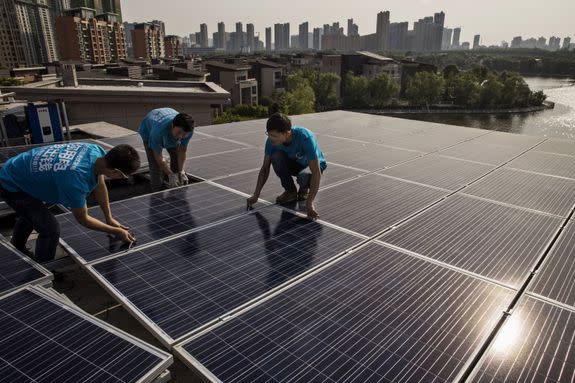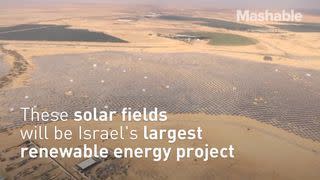Climate change efforts still 'not nearly enough' to meet Paris targets

A new clean energy report has a mixed outlook for the future: Wind and solar power will soar in coming decades, but we'll still be heading toward dangerous levels of global warming.
The big takeaway from Bloomberg New Energy Finance's (BNEF) latest analysis is that, despite the explosive growth we'll see in renewables — thanks to plummeting prices and improving technology — our current efforts simply aren't sufficient to curb greenhouse gas emissions in the long-term.
This is true regardless of whether President Donald Trump pulls the United States from the international Paris Agreement on climate change, though certainly it will be even harder to reduce emissions if that happens, said Colleen Regan, a BNEF analyst who contributed to the new report.
SEE ALSO: How clean energy is transforming the world, in 5 charts
Analysts considered existing energy policies, observed electricity prices, and price projections to forecast how the global electricity sector might look by 2040. It assumes governments and companies will build the "least-cost" power system possible.
"We see that wind and solar become some of the least-cost options in the 2020s, and that does lead to a significant amount of wind and solar build," Regan said.

Image: kevin frayer/Getty Images
Those two sources alone could account for 48 percent of installed electricity capacity and 34 percent of electricity output worldwide in around two decades — up from today's 12 percent and 5 percent, respectively, the report found.
Renewable energy as a whole could attract $7.4 trillion in global investment by 2040. That's about three-fourths of the total $10.2 trillion that will be spent on new power generation capacity.
About one-fourth of global greenhouse gas emissions come from burning coal, oil, and natural gas for electricity and heat, making it the biggest single source of emissions.
Yet all those developments won't be sufficient to prevent global temperatures from rising more than 2 degrees Celsius, or 3.6 degrees Fahrenheit, above pre-industrial levels, analysts said, meaning that central goal of the Paris Agreement likely won't be met.

Image: NASA GISS
The BNEF report says global emissions from electricity will likely hit their peak in 2026 as governments and companies shift away from coal and toward lower-carbon sources, such as wind and solar power, in step with the promises of the agreement.
After peaking, emissions will decline by 1 percent per year out to 2040. That's in contrast with the International Energy Agency's forecast, which expects emissions to steadily rise for decades to come.
Yet this rate of decline "is not nearly enough for the climate," according to the report.
The 2-degree target is the line scientists say we can't cross if we're going to avoid catastrophic changes in sea level rise, extreme weather events, precipitation patterns, and other effects.

Still, the report doesn't mean the world is locked into these projections, or that the Paris treaty is entirely futile. It just means we'll need to devote far more time and money to fighting climate change than we do today.
And despite the monumental task, the world is already making significant progress in shifting toward a lower-carbon energy mix. In its annual report this week, energy giant BP pointed to the rapid rise of solar and wind power and the long-term decline of coal.
Solar power generation jumped 29.6 percent, while wind power grew by 15.6 percent, according to BP. Coal production, meanwhile, fell by a "whopping" 6.2 percent.
The U.S. hit its own clean energy milestone this spring.
#Wind and #solar in March 2017 accounted for 10% of U.S. #electricity generation for first time https://t.co/DaL3jl7rEw #PV #energy pic.twitter.com/Q5HMkhQhA9
— EIA (@EIAgov) June 14, 2017
For the first time, monthly electricity generation from wind and solar exceeded 10 percent of total U.S. generation, based on March data, the U.S. Energy Information Administration reported. That's up from 7 percent for all of 2016.
Globally, carbon emissions have remained essentially flat for the last three years thanks to rising renewable and energy efficiency projects, and to a lesser extent because of sluggish economic growth, BP said.
Countries still have a long way to go to avoid dangerous levels of global warming. But even if we're not moving fast enough, we're heading in the right direction, according to these reports.
WATCH: The world's largest solar tower is being built in Israel

